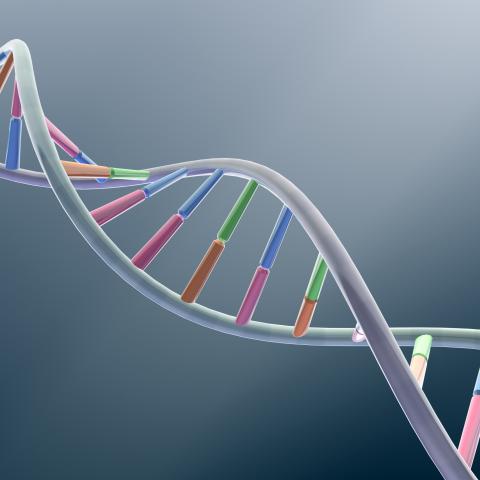
An illustration of a DNA strand. Credit: iStock
CCR scientists led by Andre Nussenzweig, Ph.D., Chief of the Laboratory of Genome Integrity, have taken an unprecedently detailed look at how a dangerous form of DNA damage arises and is repaired in dividing cells. Their study, published June 20, 2024, in Science, reveals what happens when easy-to-repair nicks in a DNA molecule are converted into potentially catastrophic double-strand breaks during the process of DNA replication. The researchers also uncovered surprising differences in how these replication-associated breaks are repaired compared to double-strand DNA breaks that occur in contexts other than replication.
Double-strand DNA breaks can trigger cell death or introduce significant errors into the genome if they are not promptly and precisely repaired. Nussenzweig explains that most of what is known about how cells cope with such breaks comes from studies of damage that occurs outside of DNA replication. It turns out cells handle double-strand breaks a bit differently when they occur as a result of DNA replication. Understanding the repair of replication-associated double-strand breaks is important for devising better cancer therapies, as many systemic chemotherapies kill cancer cells by triggering these kinds of breaks.
Replication-associated double-strand breaks occur when a region of DNA that is being copied collides with a minor form of DNA damage: a nick to one of the two strands that make up DNA’s iconic double helix. These nicks occur frequently and are usually swiftly repaired. But when a region of DNA replication — the replication fork — comes into contact with a nick before it is fixed, the problem becomes more serious. “If the cell is dividing, the replication fork will perhaps hit that lesion and then collapse into a double-strand break, which is very toxic,” Nussenzweig says.
To find out more about the formation and fate of replication-associated breaks, Nussenzweig’s team used a new type of CRISPR gene editing involving an enzyme called a Cas9 nickase. They used this tool to introduce single-strand nicks into specific sites in the genome of dividing cells cultured in the lab. Then they followed those sites as DNA replication converted the nicks into double-strand breaks and then watched the repair process unfold.
Cells have a variety of strategies for repairing DNA breaks, and some restore the original strand more faithfully than others. The replication-associated double-strand breaks that Nussenzweig and his team tracked were repaired using an error-free process called homologous recombination. Nussenzweig suspects that key components of the machinery for this type of repair may be carried along the replication fork to help protect the genome when damage arises.
That readiness might help explain the team’s discovery that replication-associated repair proceeds differently than the repair of other double-strand breaks. A surprising finding was the role of the DNA repair protein BRCA1 (whose dysfunction increases the risk of several kinds of cancer but in its normal state acts as a tumor suppressor). BRCA1 was important for the repair of replication-associated double-strand breaks, just as it is for other double-strand breaks — but the team’s experiments showed that it got involved at a different step in the process.
Nussenzweig adds that in addition to deepening the understanding of DNA break repair, his team’s findings will also help researchers predict the effects of nickases in gene editing applications. “These Cas9 nickases are being developed for clinical gene editing purposes,” he says, “so you better understand how they work. You're trying to use CRISPR Cas9 to cure disease, but when you make a nick in the DNA, you could have consequences like these collapsed forks.”


